Augmented reality is the most widespread and accessible immersive technology with tangible market growth prospects of hitting $460 billion by 2030. In addition to the entertainment industry (AR is not at all limited to masks in Snapchat), AR is being actively implemented to expand training opportunities, improve user experience, and enhance modeling and design processes.
A significant acceleration in the development of augmented reality technologies is associated with rapid progress in the creation of more advanced devices, screens, cameras, and software solutions. And most importantly, the potential of AR can benefit almost any business.
Let’s take a closer look at what AR has in store for different industries and highlight the key steps in creating an AR application.
What is Augmented Reality?
A conversation about augmented reality app development always starts with a definition – if you know everything about AR, you can skip to the next section.
Augmented reality is a technology for adding digital objects to the real world.
At this stage, this is possible only with the use of devices (tablets, smartphones, smart glasses, etc.) with specialized software. The virtual object is superimposed on the real world in real time and changes depending on the movements of the camera. We are most familiar with this from the masks that are applied to the face using the front camera of a smartphone, and the legendary game Pokémon GO, which superimposes Pokémon animals on real locations.
It is important not to confuse augmented reality with virtual reality. If the augmented one imposes individual elements on the real world, then the virtual one creates a completely virtual world, which you can immerse yourself in only with the help of special glasses and helmets – a smartphone will no longer work.
Augmented Reality on the Rise: Top Stats
Snapchat’s 2022 survey highlighted the triumphant movement of AR across different business domains. According to it, companies see AR as a great tool for deeper interactions with their customers, and 94% of respondents consider the element of fun to be the main advantage of AR. Among other advantages, respondents identified:
- Significant improvement in shopping experience (55%).
- The ability to try the product on them or in their interior before buying (79%).
- Opportunity to interact with the product before purchase (77%).
As for the growth in the number of AR users, just look at the data from Statista.
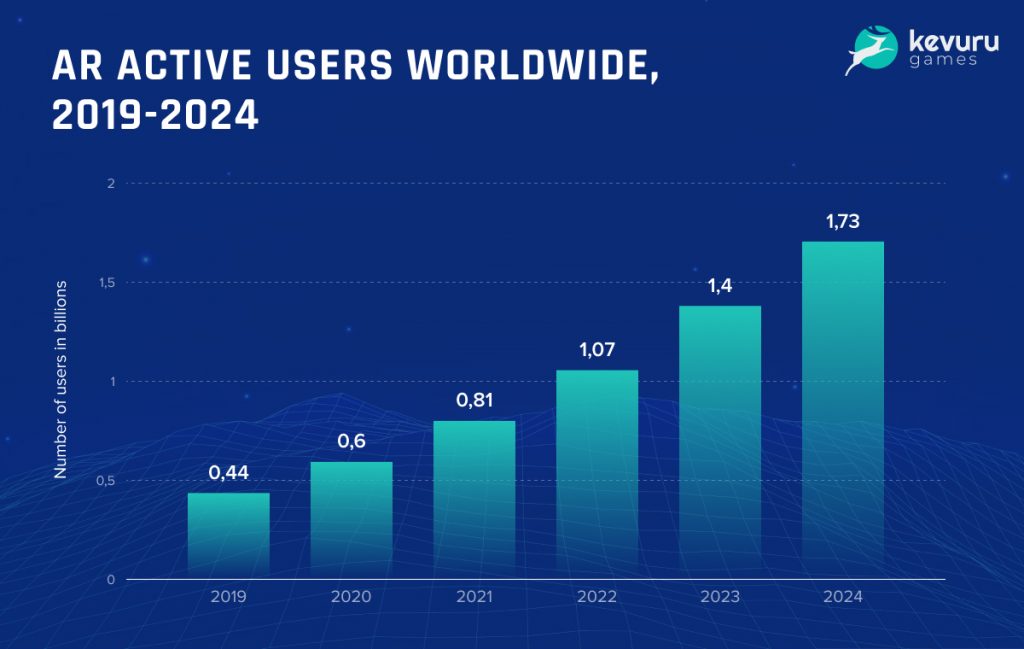
Given the steady growth and more than a billion active devices at the beginning of 2023, their number will be 1.4 billion by the end of it, and by 2024 – more than 1.7 billion. Grandview Research estimates that smart glasses will have a market value of $12.76 billion by 2030, up from $5.13 billion in 2021.
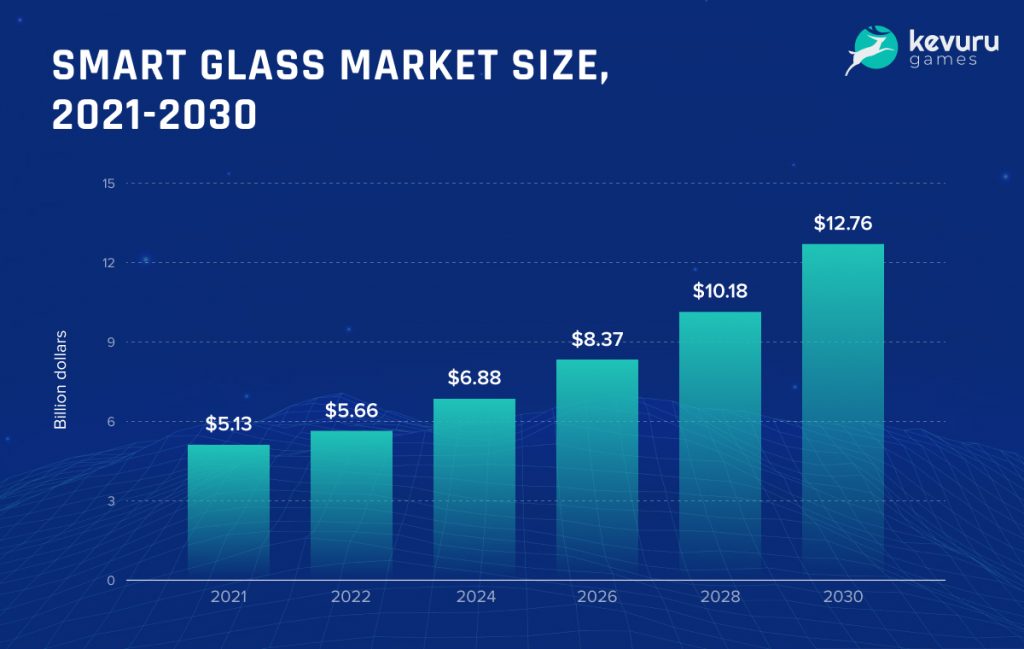
The AR software market is also growing, AR apps are gaining more and more popularity. By 2028, their market will reach $137.14 billion in comparison with $8.58 billion in 2020. Such a dizzying growth at a CAGR of 57.21% will be possible thanks to the widespread implementation of AR technology to perform different business tasks.
In the aspect of further adopting AR, some data from the McKinsey report are notable. For example, it says that with the help of the AR, it will be possible to improve and simulate 100% of the work necessary for the design of spaces and physical products. And more than 2.7 billion of the so-called deskless workers, which make up about 80% of the global labor, can become the main users of the AR technology.
Did you know? The revolutionary AR game Pokémon GO offering to catch virtual animals imposed on the real world with the help of a smartphone has become a real breakthrough and a whole cultural fenomen. At the peak moments of 2016, it totaled more than 250 million players a month, and in 2020, its revenue for the first time exceeded $1 billion.
Since everything is so rosy and promising, you probably have a question of how to build this AR app that will bring so much benefit to your business. But first, a few words about types.
Types of Augmented Reality Applications
The type of AR application is responsible for the features of user interaction and the implementation of certain goals. There are 3 key types of AR applications:
- Marker-based. Used when the subject of the camera is important for proper overlay, such as tourist info about objects, etc.
- Markerless. Used when the direction of the camera does not matter and the 3D object can be placed without a marker.
- Location-based. Used to provide the user with local information such as road signs or walking directions.
| Pros | Cons | |
| Marker-based AR | ✔️ Seamless and stable AR content ✔️ Intuitive and easy to use real-time interaction ✔️ Low development cost and production speed ✔️ Supported by low-end devices | ❌ AR content disappears when moving camera away from marker ❌ Problems with scanning in reflected light ❌ The need for clear color transitions for the marker to work |
| Markerless AR | ✔️ More flexible object placement ✔️ Unlimited camera movement without sacrificing content | ❌ The inappropriateness of AR content in a particular setting ❌ Desirable plane texture for computer vision detection |
| Location-based AR | ✔️ Convenient geolocation targeting for tourist purposes ✔️ Possibility to create options including directions ✔️ Does not require tracking of physical objects | ❌ Problems with geolocation accuracy due to inaccurate phone sensors ❌ Sufficiently high complexity of application implementation |
Mobile AR Development: Setting a Goal & Choosing the Right Platform
Creating an application is the territory of professionals – you will have to put up with it. Moreover, not every software development company has experience with AR. Take that into account and go for the ones that can prove that they know a little more about AR than “We played Pokémon GO” (even though no one actually played).
And even if you completely delegate the creation of your product to some software development company, it will not hurt you to find out the approximate stages of creating an AR application. Knowing how to start development for augmented reality apps will help you better understand the process, ask the right questions, and generally be more clear about where your money is going.
- Decide on purpose and functionality. You must clearly understand what you want from the application and what functions it should perform. Without this information, it is impossible to proceed to the next steps.
- Choose a platform. It can be Android, iOS, or a cross-platform solution. Each of them has their own convenient SDKs, but they are limited to their range of users, and the cross-platform option will help to reach the maximum audience.
- Choose the right tool. Tools and SDK are selected depending on the intended platform, the required functionality, and the chosen recognition system – marker-based, markerless, or location-based. Make sure the selected SDK supports the required features.
- Start development. The development pipeline itself may differ depending on the developer team, but usually includes the classic stages of working on the frontend and backend. Application design should be as clear and intuitive as possible.
- Promotion and marketing. Augmented reality app development will go down the drain if you don’t take care to spread the word about your app and advertise it. There are many ways: social networks, paid advertising, partnerships, events, etc.
Selecting the Right AR Stack for Your App
Now that you roughly understand how to create augmented reality apps, it becomes obvious to you that this procedure is not much different from creating any other application in its basic steps. The most important thing is to think about the essence of the implementation of AR and how it will benefit your business.
If you are interested in augmented reality development of apps in terms of specific technologies, then take a look at the following SDKs. There are many types that suit different mobile operating systems or support cross-platform development.
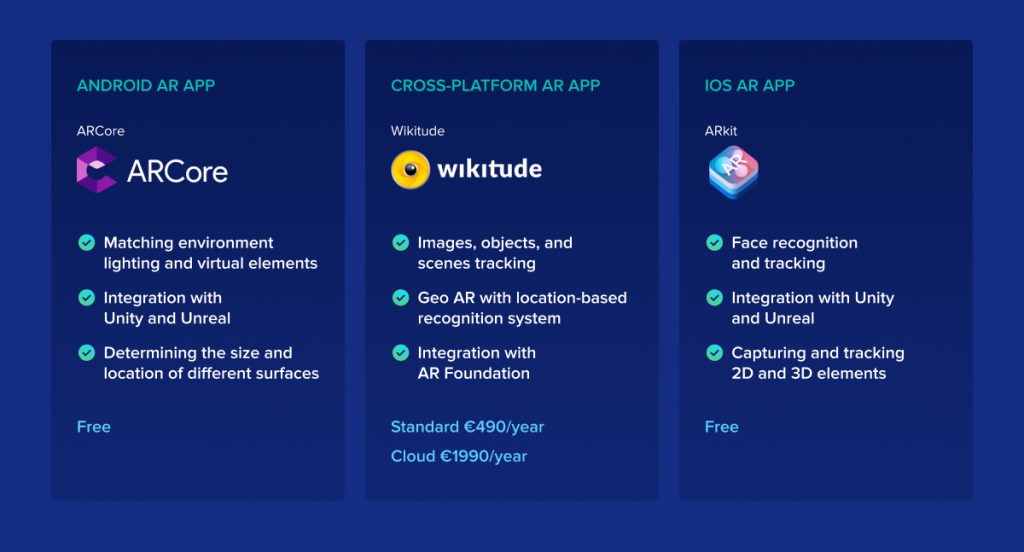
Cross-Platform AR Development
When it comes to creating AR applications, many people doubt the feasibility of cross-platform development. Native sounds more reliable.
However, the main thing to remember is that cross-platform development not only allows you to reach a significantly larger audience, it is also the best option for a limited budget. Your application will be written in one language but delivered to multiple platforms at the same time. This is done through optimization.
At the same time, cross-platform development has some drawbacks, the main of which is the limited access to hardware functionality – GPS, camera, accelerometer, and others – which is key for AR applications. Be sure to take this into account when developing. If you are planning complex applications with advanced features, the native option will be the best choice.
Bonus Tip: AR App with Unity
With a rough idea of how to build an app using ARCore and ARkit, you might be wondering – what about Unity? The answer is simple – Unity is great too. We’ve talked about how Unity is the life of the cross-platform party, and AR apps are no exception. Unity offers:
- AR Foundation is a framework for developing augmented reality applications and deploying them on different devices.
- Unity MARS aka Mixed and Augmented Reality Studio is a special extension that offers the necessary tools to implement a more streamlined workflow and create responsive and context-aware AR applications
- XR Interaction Toolkit is an interactive system for creating AR and VR experiences that allows you to take advantage of the drag-and-drop functionality to add the right components to the scene without a single line of code.
- Unity as a Library option allows using the Unity library to make it possible to add a Unity-based AR to an existing native application without having to redo it from scratch.
Dive Deeper:
✔ Unity − What Makes It the Best Game Engine?
✔ Best Game Engines of 2022: Pros, Cons, and Top Picks for Different Types of Games
How to Create a Successful AR Application: 5 highlights
Creating a successful Augmented Reality (AR) application can be a game-changer in the tech world. Whether you’re planning to enhance user experiences, revolutionize marketing, or add a touch of innovation to your business, follow these 5 authoritative highlights to guide you on your journey:
Choose the type of AR application you want to build and launch
Defining its purpose and functionality is the first step toward creating a successful AR application. AR technology offers a wide range of applications, including:
- Marker-based AR: Utilizes markers or triggers to overlay digital content onto the physical world.
- Markerless AR: Relies on environmental data to anchor digital elements in real-world surroundings.
- Projection-based AR: Projects digital content onto surfaces or objects in the physical environment.
- Location-based AR: Integrates GPS or other location-tracking technologies to deliver context-aware experiences.
Write Down the Features You Want to Add
Once you’ve identified the type of AR application you want to build, you must outline the features and functionality that will distinguish your app from competitors. Consider incorporating features such as:
- Interactive Elements: Allow users to manipulate and interact with virtual objects in real-time.
- Social Sharing: Enable users to share their AR experiences with friends and followers on social media platforms.
- Gamification: Integrate game-like elements such as challenges, rewards, and leaderboards to enhance user engagement.
- Integration with Existing Platforms: Seamlessly integrate your AR application with popular platforms like iOS, Android, or web browsers for maximum accessibility.
Choose a Tech Stack and Create a Development Strategy
Choosing the appropriate technology stack is essential for your AR application’s smooth development and scalability. Consider factors such as:
- Programming Languages: Depending on your chosen platform (e.g., iOS, Android, Unity), select languages like Swift, Java, or C# for development.
- AR Development Frameworks: Explore ARKit, ARCore, or Vuforia for streamlined AR development.
- Cloud Services: Leverage cloud-based services for data storage, processing, and real-time rendering to enhance the performance of your AR application.
Hire an AR App Developer and Complete Technical Milestones
Building a successful AR application requires a skilled team of developers with expertise in AR development frameworks and technologies. When hiring AR app developers, consider factors such as:
- Experience: Look for developers with a proven track record of building successful AR applications.
- Portfolio: Review past projects to assess the quality and creativity of their work.
- Collaboration: Ensure developers can effectively collaborate with other team members and stakeholders throughout development.
Test the Augmented Reality App and Launch the Product
Thorough testing is essential before launching your AR application to identify and address any bugs, glitches, or performance issues. Conduct extensive testing across different devices, platforms, and environments to ensure a seamless user experience.
Once testing is complete, launching your AR application to the market is time. Develop a comprehensive marketing strategy to promote your app and attract users. Consider leveraging social media, influencer partnerships, and app store optimization techniques to maximize visibility and downloads.
How Augmented Reality Technologies Help Different Industries Grow Their Business
We have already mentioned several options for the application of AR in addition to entertainment, so let’s summarize.
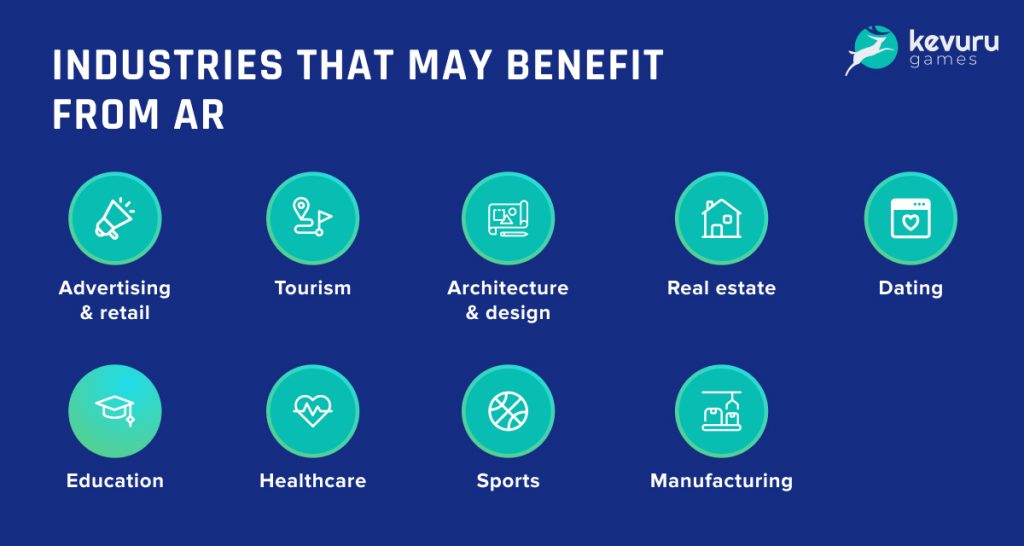
- Advertising & retail. AR ads offering to try on hats, glasses, or other clothes, see how an item looks in an interior, or test a new hairstyle and make-up received significantly higher CTR and purchases than other types of ads already in 2019.
- Tourism. Point your smartphone at a building or monument and learn more about it – this way of using AR for tourism helps travelers better navigate new places and not suffer from language barriers.
- Architecture & design. The ability to recreate interiors and design showrooms with augmented reality elements is a real blast helping designers improve accuracy, reduce errors, and save resources and money.
- Real estate. Real estate agents can gain a huge advantage over competitors by offering clients virtual tours of the apartments they are interested in, the opportunity to view any object in 3D, as well as repair options.
- Education. AR helps make learning more visual, engaging, and fun. Various 3D models related to specific topics will give students a cleaner presentation and improve memorization. The same goes for corporate training for new employees.
- Healthcare. With a long history in the medical field, AR headsets such as the HoloLens 2 are used to visualize critical patient medical data and provide guidance support for the most precise positioning of mechanical elements.
- Sports. The Hawk-Eye AR technology is used in sports to track the movement of the ball, indicating its most likely paths. Athletes can use AP in training to overlay data on the real environment or analyze recorded videos with AR to perfect their game.
- Manufacturing. AR devices can help you learn more about equipment: industrial power, temperature, performance, etc. They are also useful for overlaying production instructions, tables, statistics, and more.
- Dating. AR apps using camera and geolocation are already here to show the user if there are people nearby that match the specific parameters originally specified by the user in the app. This greatly simplifies and speeds up interactions.
And although the video game industry remains the leader in developing augmented reality apps, it no longer has an absolute monopoly on AR, just as AR has outgrown purely entertainment purposes. More and more other industries are developing augmented reality apps to realize their goals.
Here is a graph of estimated revenues up to 2025 for the largest industries using AR and VR.

How Much Does It Cost to Build an App With AR?
Taking into account all the advantages of AR applications and the wide technical choice of tools for their creation, the most relevant question remains – how much does it cost to build an AR app?
The cost of an AR application will be influenced by key factors:
- Platform choice.
- Functional.
- Deadline requirements.
But they all come down to the key aspect – the time spent on development. The more complex the application, the longer it will take to create it. And every hour of work of specialists must be paid.
On average, we can talk about amounts from $30,000 for the simplest application to options over $100,000 for more complex and advanced ones.
Interesting fact. The development cost of Pokémon GO was around $600,000.
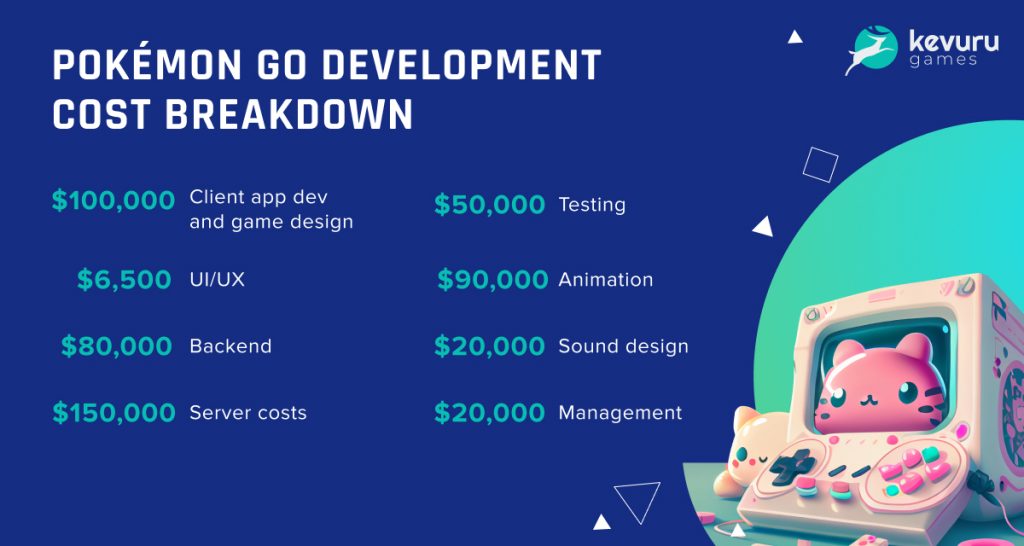
How to Create a Successful AR Application?
Augmented reality mobile app development with the current technical capabilities is not difficult. But building a successful AR app that will benefit your business is a different story. And the point is not at all in the choice of SDK or functional features.
The main thing is to know why and for whom you are creating an AR application.
A correctly and accurately formulated goal and audience is not even half the success. This is the single key to success. Take off from the target.
Do you want to increase sales? Boost engagement? Strengthen loyalty? Attract new clients? Maybe improve the effectiveness of training? Or to make access to information more visual and fast?
It’s up to you.
Paradoxically, don’t focus on how to develop augmented reality apps. Focus on why to develop augmented reality apps.
And when you have already decided on the basic concept of your application, you are ready to turn to professionals to implement it. The choice of company is also up to you.
We offer our AR development services based on extensive experience, a diversified portfolio, and always accurately hitting the goals and needs of clients. You can see our AR portfolio in the corresponding section or request a more detailed description of the AR projects we have implemented – our managers will send it to you immediately.

FAQ
How much does it cost to build an AR app?
The cost of AR applications can vary depending on their functionality and complexity and range from $13,000 to $100,000 or more if you need a more complex application.
How to choose the AR SDK?
Choosing an AR SDK, developers start from the specific requirements for an AR application and the ability to satisfy them. Among them are intended platforms, GPS, support for image recognition, cost, and others.
How to build an AR marketing app?
Building an AR marketing application is best left to a company that has similar experience. To create an AR application, such a company will ask you to answer several key questions, such as the type of application you need, its features and functionality, time and budget constraints, and so on. Next, the company will select the necessary technical stack, form a team, approve the pipeline, and begin development.









